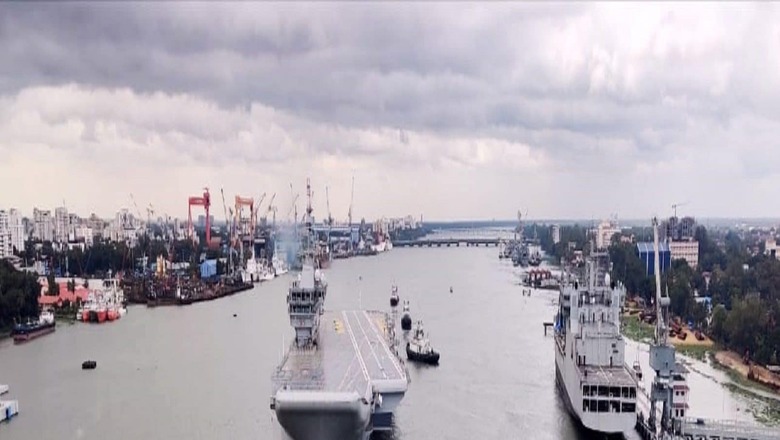
views
India’s Naval Air Arm turned 68 earlier this year, and no one can contest that it has been vital in times of war as well as peace. From the liberation of Goa through to present-day natural disasters, naval aircraft—whether fighters, submarine-hunters, or helicopters—have been committed to operations across India and the region.
The past month has seen naval aviation in the news for a multitude of reasons. First was the maiden sea trial of the indigenous aircraft carrier (IAC-1), to be named Vikrant. The five-day sail, first of a series of planned trials before delivery, saw various elements of the ship being put through their paces, and even a few helicopter embarkations. The award of the President’s Colours to Naval Aviation was announced soon after, which will take place at the ceremonial parade in Goa on September 6. Colours for naval aviation is a recognition of the worth and contribution of the entire aerospace enterprise of the Navy, ashore and at sea, and is certainly well deserved, arguably overdue.
But it is the final element of the Indian Navy’s prominence in the past month that should temper any exuberance. From the Western Pacific to the English Channel, the Indian warships ‘fly the flag’ and exercise with partner navies. This is vital for securing Indian interests and bolstering Indian credibility at sea.
However, when Indian vessels, or, more precisely, their embarked helicopters, are juxtaposed with those they operate alongside, it exposes how New Delhi’s maritime ambitions are resourced.
The Navy’s Helicopter Problem
Take the exercise with the Talwar-class frigate INS Trikand and the German Brandenburg-class frigate Bayern—images of an all-weather, day-night capable German Westland Lynx Mk.88A with its sensor-laden nose landing on the Indian frigate’s deck are almost embarrassing alongside the venerable HAL Chetak, with only an electronic surveillance suite on board and negligible capability to fly by night or in adverse weather.
The comparison only gets worse when one factors in the age and service status of the two helicopters. The Germans procured the Lynx in the early 1980s, upgraded the fleet in the late-1990s, and have begun the process of not only replacing them with the far more capable NH90, but also expanding their number from 22 to 31. India, on the other hand, contracted its Chetaks (as Sud Aviation Alouette IIIs) as far back as 1961, with the Navy taking delivery of the first aircraft in 1964. The helicopters have soldiered on almost unchanged for nearly 60 years since, and were still in production by HAL as of last year.
The Navy’s helicopter situation is dire, yet is only being addressed piecemeal—which is not ideal for the service or the defence industry that successive governments claim to want to nurture. With over 50 Chetaks in service, orders for a handful of HAL Advanced Light Helicopters (ALH) will have little impact on actual operations. A large-scale replacement for the Chetak was stymied by HAL’s efforts to force-fit its non-compliant ALH to the Navy’s warship hangars. Although the impasse appears to have been resolved in HAL’s favour for the moment, until the state-owned PSU is actually able to modify, certify, and deliver ALHs that can go to sea, the Chetak is likely to see out its 60th year in naval service.
The medium helicopters have fared no better. Although a welcome procurement was announced with a great deal of fanfare in 2020, the 24 Sikorsky MH-60R multirole helicopters on contract for the Navy do not even cater for a one-to-one replacement of existing aircraft, let alone on expanding the fleet. The Navy already operates over 30 surface vessels designed to operate medium helicopters, and a similar number of ageing Sea King helicopters dating to the 1980s and 1990s.
Crucially, however, there are a dozen more capital ships in construction, as well as an aircraft carrier on the verge of commissioning, which means that very soon there will be far more vessels in the water than helicopters to embark them. Given the impending retirement of their host Rajput-class destroyers, the Navy’s sub-fleet of obsolescent Soviet Kamov Ka-28 anti-submarine helicopters may also be divested, further widening the medium helicopter gap.
There are no easy answers to a problem decades in the making.
If HAL’s proposal for a modified ALH that meets the Navy’s requirement bears fruit, there is little question that the resulting helicopter should form the basis for the Navy’s seagoing rotorcraft fleet. The issues are of time and cost. Every year the definitive ALH is not available is a year that frontline warships are sailing the high seas all with severely curtailed capabilities, most significantly in the anti-submarine domain. A maritime conflict flaring up at this point in time does not bear thinking about. But even if the hypothetical success story begins deliveries five or six years hence, the government will have to consider the opportunity cost of having let these years slip by.
Could the Navy have gone ahead with their proposed helicopter buy and freed HAL up to focus on advancing the indigenous medium helicopter? Similar questions will dog the upcoming naval carrier fighter and LCA Mk.2 as they compete for time and resources with lower hanging fruit. This is the cost to be paid for perennially delayed decision-making—and Indian Aviation is littered with money ill-spent and a host of haunting ‘what-ifs.’
This article was first published on ORF.
The author is a Project Coordinator with ORF’s Strategic Studies Programme. The views expressed in this article are those of the author and do not represent the stand of this publication.
Read all the Latest News, Breaking News and Assembly Elections Live Updates here.














Comments
0 comment